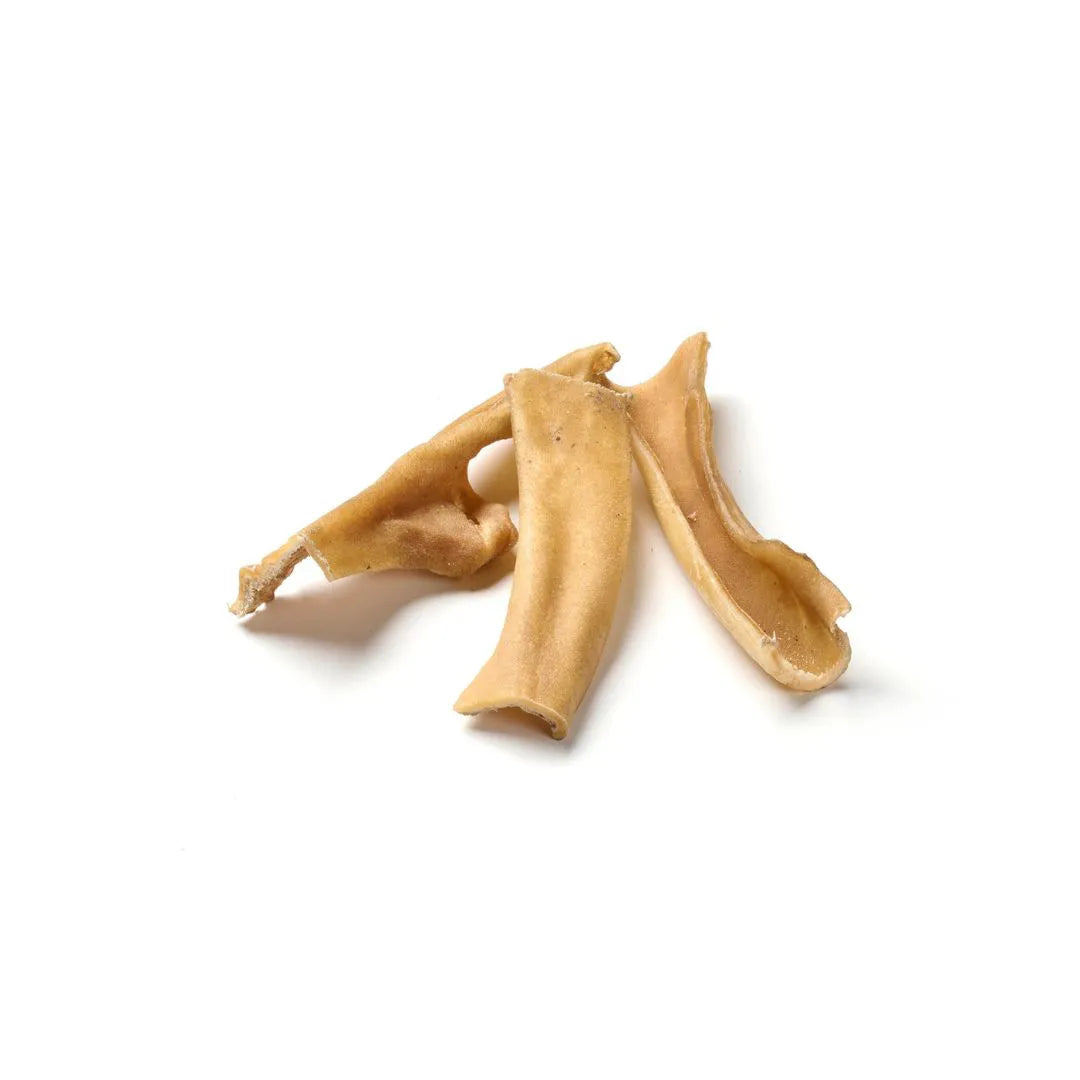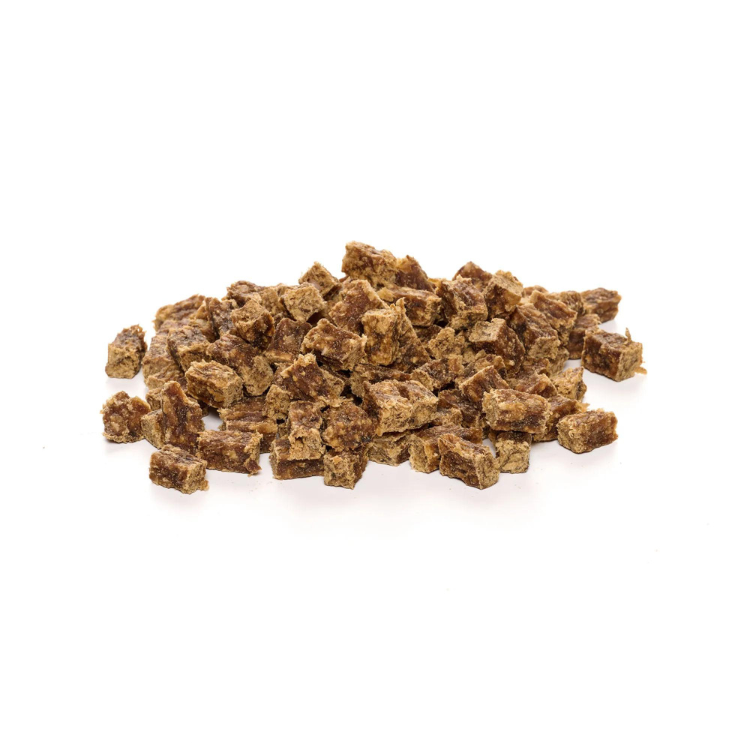
When is a dog fully grown?
Share
Most young dogs move in with their new family between the 10th and 12th week of life. From now on, a small, active and curious puppy lives with you, which grows rapidly in the following weeks and months and learns something new every day. The question often arises as to how big your four-legged friend will actually get? Here you can find out what you need to look out for!
Contents: When is a dog fully grown?
- The growth phases of the dog
- How fast is my dog growing
- Puberty & Co. – The emotional development of dogs
- Conclusion
Discover our selection of premium dog chews!
The growth phases of the dog
The stages of growth are the same for all dog breeds. After birth, every puppy goes through seven stages of development, regardless of its breed, size, etc.
Week 1 & 2
Weeks 1 and 2 are called the neonatal phase. The dog's sense of smell is already well developed from the start, but the eyes and external auditory canals are still closed.
The puppy spends almost the entire day sleeping and drinking its mother's milk. Since the little dog cannot yet regulate its own body temperature, it must always be kept warm.
See also:
Week 3
Week 3 is the transition phase. Eyes and hearing are now open, your puppy can see and hear. He begins to perceive his surroundings and siblings, shows an increasing need for movement and begins teething.
Week 4 - 7
In the 4th to 7th week, the imprinting phase, the puppy's curiosity grows day by day, it becomes more and more involved with its surroundings, and its future temperament begins to show. Puppies must not be left alone during this phase.
Week 8 - 12
Weeks 8 to 12 are the socialization phase, in which your dog's future social behavior is shaped. The puppy develops self-confidence, copes with the unknown and gets to know its surroundings better. The little dog should not be overwhelmed.
Month 3 - 6
In the rank and pack order phase between the 3rd and 6th month, your four-legged friend must now find his way into your "pack". Through clear and understandable rules, your dog can recognize and accept a rank order and find his place in it.
Month 7 - 12
Months 7 to 12: The puberty phase. Dogs also go through puberty and test their limits - and yours. During this "tantrum phase", female dogs come into heat for the first time, and male dogs have the urge to reproduce. During this phase, your patience is required; you should be caring, but also consistent.
Month 12 - 30
Months 12 to 30 are called the maturity phase. This last phase is the transition from puppy to adult dog. Growth is now complete - but that doesn't mean that your dog doesn't want to be further stimulated and challenged physically and mentally. Just like humans, your dog never stops learning.
How fast is my dog growing?
You are surely always amazed at how quickly your dog changes and how quickly he grows. Dogs multiply their weight and size within a short period of time.
A Great Dane, for example, has increased its birth weight a hundredfold by the age of one year; in smaller dogs, the difference between birth weight and adult weight is not so great; a dachshund weighs only about 25 times as much as it did at birth when it is an adult.
A dog's growth curve shows how quickly the four-legged friend is ideally growing and how much weight he should gain. The vet also uses such dog growth curves to check whether your dog is developing healthily for his age.
Large breed dogs such as Newfoundlands or St. Bernards sometimes need between one and a half and two years to reach full maturity. A dog's growth curve shows how quickly the four-legged friend ideally grows and how much weight it should gain.
Pamper your dog with our delicious chews!
How big will my dog be?
If you know your puppy's parents, you can use their size to estimate how big your new family member will eventually be. With mixed breeds, it can sometimes be a little difficult to predict what size they will reach as adults.
Pedigree dogs, on the other hand, have set breed standards, which usually also include information about the dog's withers height. This makes it easier to reliably predict what the four-legged friend's final size will be.
In addition, at around two months of age, you can get a good idea of how big your dog will be as an adult. For example, if a two-month-old puppy is 20 to 28 centimeters tall, it will probably grow into a medium-sized dog and measure around 40 to 48 centimeters when fully grown.
If the puppy is smaller at this point, it is a small dog under 40 cm. If it is larger at two months, you can expect your dog to reach a height of over 50 centimeters. Also note that males tend to grow a little larger than females of the same breed.
An X-ray examination by your veterinarian can provide clarity as to whether your dog is fully grown. The professional can use the growth plates to determine whether the animal has reached its maximum growth point or approximately how big your furry friend will be. The doctor will examine the distance between the growth plates.
By the way, it is not true - even if this opinion is widespread - that the size of a puppy's paws can provide reliable information about the future size of the dog. A puppy with big paws does not have to become a big dog and a puppy with small paws does not have to remain a tiny one.
Puberty & Co. – The emotional development of dogs
For both humans and dogs, growing up means not only physical growth, but also emotional maturity. Growing up also includes psychological development, which takes more time than physical growth. Therefore, you should place great value on everything that can have a positive influence on development.
Emotional development, like physical development, depends on the size and breed of the animal; that of small breeds often seems to be completed much faster than that of large dogs.
Boisterous phase
An important step in your dog’s emotional development and towards adulthood is the so-called “tear-up phase”.
Do you sometimes wonder what actually happened to your cute, easy-care and well-behaved puppy between the 7th and 12th month of your dog's life?
Maybe you are a little desperate because you no longer recognize your dog's behavior?
Your "darling" is suddenly behaving rebelliously, ignoring his master's orders and seems to have forgotten everything he has learned up to now - if he even listens anymore. Don't panic, your dog is simply going through puberty! And it will pass too.
With patience, consistency and frequent repetition of exercises and commands, it will be easier for your four-legged friend to internalize what he has learned. Your dog is now sexually mature. Bitches come into heat for the first time, and in males you can recognize this developmental step when he starts lifting his legs. Depending on the disposition and breed, the hunting instinct also awakens in this phase of life.
Emotional maturity
However, an important step towards adulthood for dogs is not only the attainment of sexual maturity and thus the ability to reproduce, but also the attainment of emotional maturity.
Your dog's character traits and unique personality now become clearly apparent, solidify, and the typical appearance of a young dog gradually disappears.
Your housemate looks more grown-up and will probably not be so easily disturbed. Most dogs are adults from around three years of age, depending on their size and breed. Here too, smaller breeds grow up faster and large breed dogs generally need significantly more time.
Large dog breeds are usually not considered adults until they are around 30 months old. For very large breeds and “late developers” – yes, dogs do have those too! – this process can even take up to four years.
Conclusion
As with humans, a dog's growth and adulthood is a process. When your young dog no longer behaves like a puppy or unreasonable teenager, the time has come:
He has grown up. But that doesn't happen overnight.
There is therefore no absolute point in time when this developmental step is completed. Your adult dog gives you the feeling that the two of you belong together. You are now a well-coordinated team and know each other's characteristics and "quirks".
In general, your four-legged friend will listen to your instructions again during training, will have fewer conflicts with other dogs and will relax much more quickly. If you have trained your dog well, this will now be reflected in his stable, balanced character.
Reward your best friend with our dog treats!















